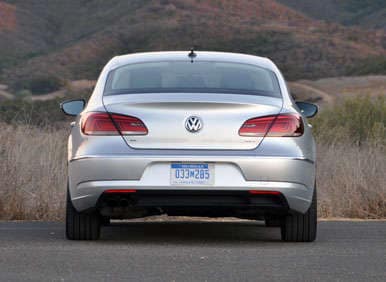Recent Articles
Popular Makes
Body Types
2013 Volkswagen CC Road Test and Review
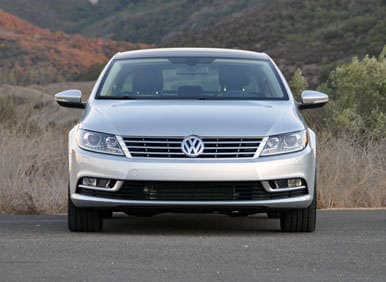
Back in the 1980s, Billy Crystal famously performed as Fernando Lamas on Saturday Night Live and popularized the catch-phrase “You look marvelous.” During a week spent driving the refreshed 2013 Volkswagen CC, an abbreviation for “comfort coupe,” we frequently thought of Crystal’s over-the-top delivery of this line, because the 2013 VW CC does look marvelous. As it turns out, the styling is the best reason to buy this car.
2013 Volkswagen CC Review: Pricing and Trim Levels
Volkswagen sells the 2013 CC in 2.0T Sport, 2.0T Sport Plus, 2.0T R-Line, 2.0T Lux, V6 Lux, and VR6 4Motion Executive trim levels. The 2.0T models are equipped with a turbocharged 4-cylinder engine, while the V6 and VR6 models have a V-6 engine tucked under the hood.
Prices start at $31,435 for the 2.0T Sport, including the $825 destination charge. The 2.0T Sport is equipped with a manual transmission, 17-inch aluminum wheels, bi-Xenon headlights, and LED taillights. Inside, the 2.0T Sport includes 12-way power front sport seats, leatherette seat upholstery, dual-zone automatic climate control, a tilt/telescopic steering wheel, Bluetooth connectivity, and a touchscreen radio with satellite radio, HD radio, and iPod connectivity. To this list of features, the 2.0T R-Line ($33,020) has a body kit, 18-inch aluminum wheels, and a navigation system.
The 2.0T Sport Plus ($33,675) builds on 2.0T Sport equipment with adaptive headlights that pivot with the steering to help the driver to see around dark corners, 18-inch aluminum wheels, a navigation system, and a standard Direct Shift Gearbox (DSG) automated manual transmission.
The 2.0T Lux ($36,180) model gains a power sunroof, ambient interior lighting, dark brushed aluminum interior trim, and a unique wheel design. This is the model we test drove, and is the car in the accompanying photos.
For a V-6 engine, the CC V6 Lux model is the car you want. It starts at $38,555 and adds a 3.6-liter V-6 engine, genuine leather seats, 12-way power front seats with 4-way power lumbar support and memory for the position settings, woodgrain interior trim, auto-dimming side mirrors, and an upgraded navigation system with a reversing camera. The standard 18-inch aluminum wheels are specific to this model.
The CC VR6 4Motion Executive model ($42,245) adds all-wheel drive, a massaging driver’s seat, ventilated front seats, a premium Dynaudio sound system, a power rear sunshade, and front and rear parking sensors. You can tell this model apart from the others by its polished aluminum wheels.
Dealers can install a handful of options for the CC, including a rear lip spoiler, chrome exhaust tips, a cargo net, a first-aid kit, upgraded floor mats, and more.
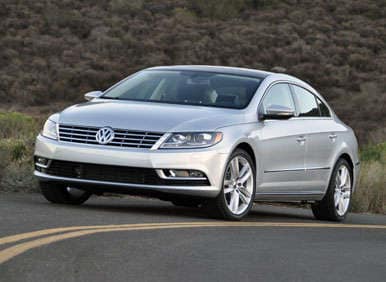
2013 Volkswagen CC Review: What It's Up Against
With a price spread from the low-$30Ks to the low-$40Ks, the 2013 Volkswagen CC is positioned to compete primarily against entry-level luxury vehicles equipped with 4-cylinder or V-6 powertrains. This includes the Acura TL, Acura TSX, Audi A4, BMW 3 Series, Buick LaCrosse, Buick Regal, Buick Verano Turbo, Cadillac ATS, Cadillac CTS, Chrysler 300, Infiniti G Sedan, Lexus ES, Lexus IS, Lincoln MKZ, Mercedes-Benz C-Class, and Volvo S60.
However, it is worth noting that the 2.0T Sport, Sport Plus, and R-Line models are priced right where full-equipped versions of mainstream family sedans are positioned. That list includes the Chevy Malibu LTZ Turbo, Dodge Charger SXT Plus, Ford Fusion Titanium, Honda Accord Touring, Hyundai Sonata Limited, Kia Optima SXL, Mazda 6s Grand Touring, Nissan Altima SL, Subaru Legacy Limited, Toyota Camry XLE, and even Volkswagen’s own Passat SEL.
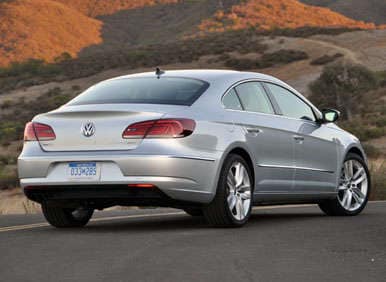
2013 Volkswagen CC Review: Exterior
- New styling front and rear
- New aluminum wheel designs
- New exterior color choices
- Standard bi-Xenon headlights
- Standard LED running lights
- Standard LED taillights
- Optional R-Line Package
Though commonly referred to as a “4-door coupe,” the 2013 VW CC is actually a rakish 4-door sedan equipped with frameless glass and a fastback roofline. This design trend kicked off nearly a decade ago with the 2004 Mercedes-Benz CLS-Class, which even today arguably remains the most attractive of the breed. Numerous luxury automakers followed Benz’s lead, and the CLS spawned a number of similarly styled and positioned models.
But Volkswagen is the only car company to apply the design to a mainstream model.
Basically, the CC is the previous generation 2006-2010 Volkswagen Passat wearing a new suit. The result is a terrific looking car, more attractive than most other 4-door coupes – even those costing twice the price, but while this Volkswagen looks classy and upscale, especially compared to some of the mainstream models against which it competes, buyers should keep in mind that its basic engineering is now 8 years old.
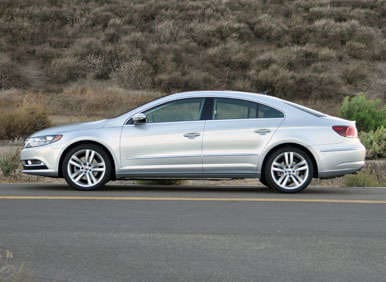
2013 Volkswagen CC Review: Interior
- New 5-passenger seating configuration
From the outside, the 2013 Volkswagen CC’s previous-gen Passat platform is invisible. Open the door, and anyone familiar with the old Passat will instantly recognize the CC’s dashboard design, which is a greatest tell hinting at the aging mechanicals under the car’s skin.
Another sign that the CC is getting old, and quick, is that the inside of this car creaks and squeaks constantly. The materials are of quality, and nothing feels loose or poorly assembled, but there is definitely an issue with the way they fit and rub together. After a cold night (for California, anyway) I popped the trunk and the hinges squeaked. None of this is what someone expects after dropping $36,000 on a new entry-luxury sedan.
The main complaint that I have with the CC pertains to outward visibility. This car is really hard to see out of. The roof pillars are thick, the rear window is small and frequently full of reflections, and the front headrests are large. Yet, Volkswagen reserves a reversing camera for the V6 Lux and parking assist sensors for the VR6 4Motion Executive models, and doesn’t offer a blind-spot warning system no matter how much money you have to spend.
During my week with the CC 2.0T Lux, this proved to be my biggest issue with the car, and then on the day before returning it I actually backed it into a concrete wall in a tight parking garage. Seriously, Volkswagen, rear parking assist sensors ought to be standard on the CC. At a minimum.
While I’m on a rant, I might as well tell you that its difficult to get into and out of the CC, especially for taller people, and especially if you like to sit tall behind the steering wheel. The dramatically arched windshield pillars force the driver and front passenger to duck low, almost folding themselves in half and twisting around the B-pillar to get in. The lower plastic trim on our test vehicle’s left B-pillar was already scratched up from people rubbing their butts on it while entering and exiting, and our car had fewer than 9,000 miles on odometer.
Believe it or not, entry and exit to the rear seat is a little easier, but loading children into child safety seats is a hassle because of the low, curving roofline. Plus, the CC’s rear doors are lethal to adjacent cars in parking lots. They lack a final detent where a person expects one to be, allowing the doors to suddenly and unexpectedly swing wide.
Until 2013, the Volkswagen CC was a 4-passenger vehicle equipped with individual rear seats separated by a small console. Now, the CC offers 5-passenger seating, a change that we doubt will actually benefit most owners but which does give the CC greater flexibility.
Once everyone is inside, there’s plenty of room for 4 full-size adults, and headroom is unexpectedly generous given the CC’s styling. The front seats offer exceptional comfort and adjustment, and the driving position is perfect. Our test car had a black/tan 2-tone interior treatment, and I’m glad that Volkswagen allows buyers to choose this color combination with silver paint.
Gauge clarity could not be better, the controls are logically arranged, and I adore the stout door panel handgrips provided for each outboard passenger. I’m not a fan of VW’s touchscreen radio system, however. I just don’t understand why there can’t be a power/volume knob, a tuning/sound knob, and something else for secondary system functions. Keep it simple!
Like most German cars, the CC’s 13.2 cu.-ft. trunk is beautifully finished, is usefully shaped like a cube, and supplies a grip to use for closing the lid.
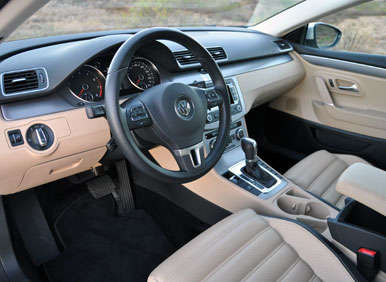
2013 Volkswagen CC Review: Matters of Safety
- No changes
The 2013 Volkswagen CC is equipped with six airbags, a traction and stability control system, and 4-wheel-disc antilock brakes with brake assist. A reversing camera is included on models with a V-6 engine, deftly tucked underneath the VW badge on the trunk lid, and the top-of-the-line VR6 4Motion Executive model is equipped with front and rear parking sensors.
As we’ve mentioned, we think Volkswagen needs to expand the availability of the reversing camera and parking sensors, especially on a model that offers such awful outward visibility.
The 2013 VW CC is a safe car, if the Insurance Institute for Highway Safety (IIHS) has anything to say about it. The IIHS calls the CC a “Top Safety Pick” based on its performance in frontal-impact, side-impact, rear-impact, and roof crush strength tests. The National Highway Traffic Safety Administration (NHTSA) hasn’t performed crash tests on the CC, but gives the car a 4-Star rollover resistance rating.
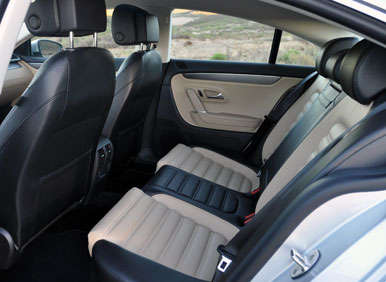
2013 Volkswagen CC Review: Powertrain
- No changes
Volkswagen offers the CC with a choice between two engines. The CC 2.0T models get a turbocharged 2.0-liter 4-cylinder engine generating 200 horsepower between 5,100 rpm and 6,000 rpm, and 207 lb.-ft. of torque between 1,700 rpm and 5,000 rpm. A 6-speed manual gearbox is standard on the 2.0T Sport and 2.0T R-Line models, with VW’s Direct Shift Gearbox (DSG) automated manual transmission optional. The DSG is standard on 2.0T Sport Plus and 2.0T Lux models.
Let’s translate this data for you. Because either peak torque or peak horsepower are available from just 1,700 rpm all the way to 6,000 rpm, this 4-cylinder engine feels much stronger than its power ratings might suggest, proving lively and responsive from almost any speed. Turbo lag is somewhat problematic right off the line, but the driver can easily acclimate to this characteristic.
A 3.6-liter V-6 is standard on V6 Lux and VR6 4Motion Executive models, making 280 horsepower at 6,200 rpm and 265 lb.-ft. of torque at 2,750 rpm. A 6-speed automatic transmission is standard, and VR6 4Motion Executive models are equipped with all-wheel drive.
Fuel economy ratings range from a low of 17 mpg in the city for the V-6 engine to a high of 32 mpg on the highway for the turbocharged 4-cylinder with the manual transmission on the highway. Our test car, a 2.0T Lux with DSG, should have returned 25 mpg in combined driving, according to the EPA. We got 23.8 mpg.

2013 Volkswagen CC Review: How It Drives
The 2013 Volkswagen CC 2.0T’s Direct Shift Gearbox (DSG) transmission offers two driving modes: Normal and Sport. If you’re looking for shifter paddles, or a manual shift gate, you’re not going to find them inside of the CC.
In Normal mode, the DSG upshifts rapidly and exhibits noticeable turbo lag. Shifting into Sport mode resolves the turbo lag situation to some degree, and the car feels more responsive because the transmission holds lower gears for a longer period of time. On the highway, however, it is wise to place the gear selector back into the Normal drive setting because in Sport mode the engine spins at higher revs and consumes more fuel.
Despite the DSG’s inability to adapt to driving situations, and in spite of its lack of oomph while the turbocharger is getting ready to rock, I still love VW’s turbocharged 2.0-liter 4-cylinder. This car feels far more powerful than its power ratings suggest, and represents a case study in why torque is often the more important metric than horsepower.
However, for a vehicle equipped with a 4-cylinder engine, it certainly feels like a disproportionate amount of the CC’s 3,329 pounds is sitting over the front wheels. Part of this sensation is attributable to the soft suspension tuning, but I’d guess part of it is also due to this platform’s advancing age. Plus, when driven with gusto, the CC understeers fairly early on its P235/40R18 all-season tires.
Set the enthusiastic driving level at “moderate verve,” and the CC feels livelier and better connected. The suspension is tuned for ride comfort, an observation made obvious by how the car’s nose bounds and sways over dips, but like other softly-sprung VW’s, the CC’s underpinnings are calibrated to erase body roll in corners and curves. This flat handling attitude, combined with perfectly weighted and precise steering, makes the CC pleasing to drive the majority of the time.
The braking system is where Volkswagen might wish to revise its approach to mechanical components. The CC’s brake pedal feels too soft, almost mushy, and on a 75-degree testing day the brakes faded during an energetic drive in the mountains. While it is true that we experienced diminished braking power near the end of a long downhill run with more than 450 pounds of passenger aboard, it is a rare occasion when we’re able to coax brake fade from a modern car.
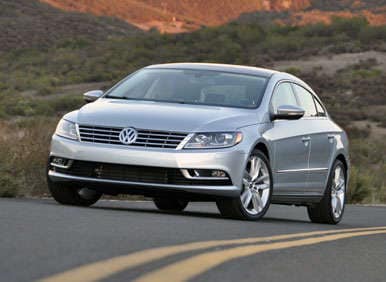
2013 Volkswagen CC Review: Final Thoughts
The main reasons to buy a 2013 Volkswagen CC are for its styling and for the image it conveys. Otherwise, from the age of the CC’s platform and its creaking interior components to packaging compromises forced by its design and pricing compromises due to its position atop VW’s car lineup, the CC lacks practicality and value.
But, as Fernando Lamas would say: “Remember darlings, it is better to look good, than to feel good.”
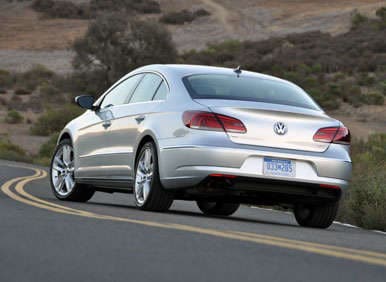
2013 Volkswagen CC Review: Pros and Cons
Pros:
- Styling
- Seat comfort
- Driving position
- Turbocharged engine in 2.0T models
- “Top Safety Pick” crash-test rating
- Available all-wheel drive with V-6 engine
Cons:
- Outward visibility
- Difficult entry and exit
- Creaking and squeaking interior
- Reversing camera requires V-6 engine
- Parking assist sensors require expensive Executive model
- Aging component set
Volkswagen provided the vehicle for this review
2013 Volkswagen CC Photos by Christian Wardlaw
